International Journal of Intelligent Systems and Applications @ijisa
Статьи журнала - International Journal of Intelligent Systems and Applications
Все статьи: 1203

Modeling Uncertainty in Ontologies using Rough Set
Статья научная
Modeling the uncertain aspect of the world in ontologies is attracting a lot of interests to ontologies builders especially in the World Wide Web community. This paper defines a way of handling uncertainty in description logic ontologies without remodeling existing ontologies or altering the syntax of existing ontologies modeling languages. We show that the source of vagueness in an ontology is from vague attributes and vague roles. Therefore, to have a clear separation between crisp concepts and vague concepts, the set of roles R is split into two distinct sets Rcand Rvrepresenting the set of crisp roles and the set of vague roles respectively. Similarly, the set of attributes A was split into two distinct sets Acand Avrepresenting the set of crisp attributes and the set of vague attributes respectively. Concepts are therefore clearly classified as crisp concepts or vague concepts depending on whether vague attributes or vague roles are used in its conceptualization or not. The concept of rough set introduced by Pawlak is used to measure the degree of satisfiability of vague concepts as well as vague roles. In this approach, the cost of reengineering existing ontologies in order to cope with reasoning over the uncertain aspects of the world is minimal.
Бесплатно
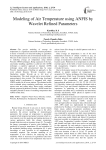
Modeling of Air Temperature using ANFIS by Wavelet Refined Parameters
Статья научная
The precise modeling of average air temperature is a significant and much essential parameter in frame of reference for decision-making in agriculture field, drought detection and environmental related issues. The aim of this research is to construct an accurate model to modeling average air temperature using hybrid Wavelet-ANFIS techniques. Being cognizant of the fact, uncertainty handling capability is achieved with ANFIS technique; a cognitive approach to integrate ANFIS technique along with pre-processed data by using Wavelet transformation. Detailing on approach, in this work utilized Discrete Wavelet transform under Daubechies mother Wavelet up to 3rd level of decomposition. This study extends up to seven station's meteorological data records. The following developed hybrid model's performance is compared with single ANFIS models for all seven stations. The obtained results were evaluated using correlation coefficient, root mean square error and scatter index These results confirmed that the proposed hybridized Wavelet- ANFIS model has estimable potential in terms of modeling temperature than ANFIS model alone.
Бесплатно
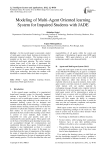
Modeling of Multi-Agent Oriented learning System for Impaired Students with JADE
Статья научная
In this research paper we presented a model of multi-agent system based learning environment for physically impaired students. The learning system is modeled on the basis of both centralized as well as distributed multi-agent planning. The entire learning system keeps track of the type of impairment the student has and mode of interaction of the environment is set depending on the type of impairment(s). The system consists of agents which are developed using JADE agent technology that helps the students with disabilities to continue studies from their own places.
Бесплатно
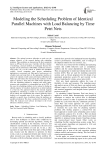
Статья научная
The optimal resources allocation to tasks was the primary objective of the research dealing with scheduling problems. These problems are characterized by their complexity, known as NP-hard in most cases. Currently with the evolution of technology, classical methods are inadequate because they degrade system performance (inflexibility, inefficient resources using policy, etc.). In the context of parallel and distributed systems, several computing units process multitasking applications in concurrent way. Main goal of such process is to schedule tasks and map them on the appropriate machines to achieve the optimal overall system performance (Minimize the Make-span and balance the load among the machines). In this paper we present a Time Petri Net (TPN) based approach to solve the scheduling problem by mapping each entity (tasks, resources and constraints) to correspondent one in the TPN. In this case, the scheduling problem can be reduced to finding an optimal sequence of transitions leading from an initial marking to a final one. Our approach improves the classical mapping algorithms by introducing a control over resources allocation and by taking into consideration the resource balancing aspect leading to an acceptable state of the system. The approach is applied to a specific class of problems where the machines are parallel and identical. This class is analyzed by using the TiNA (Time Net Analyzer) tool software developed in the LAAS laboratory (Toulouse, France).
Бесплатно
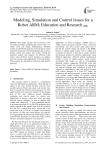
Modeling, Simulation and Control Issues for a Robot ARM; Education and Research (III)
Статья научная
This paper extends writer's previous work and proposes design, modeling and control issues of a simple robot arm design. Mathematical, Simulink models and MATLAB program are developed to return maximum numerical visual and graphical data to select, design, control and analyze arm system. Testing the proposed models and program for different input values, when different control strategies are applied, show the accuracy and applicability of derived models. The proposed are intended for education and research purposes.
Бесплатно
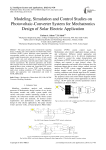
Статья научная
This paper presents some considerations regarding design, modeling and control solutions for Photovoltaic Panel-Converter (PVPC) system. Different control approaches and corresponding models are derived, developed and tested, to control output characteristics and performance of both overall PVPC system and each subsystem to meet desired output characteristics, performance and both and/or either voltages and currents requirements. The proposed approaches and models allow designer have the maximum output numerical visual and graphical data to select, evaluate and control the PVPC system output characteristics for a given PVPC system parameters, under given working conditions of PV panel. The proposed models and approaches were implemented and tested in MATLAB/Simulink.
Бесплатно
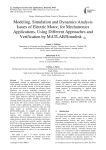
Статья научная
The accurate control of motion is a fundamental concern in mechatronics applications, where placing an object in the exact desired location with the exact possible amount of force and torque at the correct exact time is essential for efficient system operation. An accurate modeling, simulation and dynamics analysis of actuators for mechatronics motion control applications is of big concern. The ultimate goal of this paper addresses different approaches used to derive mathematical models, building corresponding simulink models and dynamic analysis of the basic open loop electric DC motor system, used in mechatronics motion control applications, particularly, to design, construct and control of a mechatronics robot arm with single degree of freedom, and verification by MATLAB/Simulink. To simplify and accelerate the process of DC motors sizing, selection, dynamic analysis and evaluation for different motion applications, different mathematical models in terms of output position, speed, current, acceleration and torque, as well as corresponding simulink models, supporting MATLAB m.file and general function block models are to be introduced. The introduced models were verified using MATLAB/ Simulink. These models are intended for research purposes as well as for the application in educational process. This paper is part I of writers' research about mechatronics motion control, the ultimate goal of this research addresses design, modeling, simulation, dynamics analysis and controller selection and design issues, of mechatronics single joint robot arm. where a electric DC motor is used and a control system is selected and designed to move a Robot arm to a desired output position, θ corresponding to applied input voltage, Vin and satisfying all required design specifications.
Бесплатно
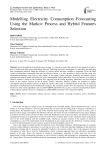
Modelling Electricity Consumption Forecasting Using the Markov Process and Hybrid Features Selection
Статья научная
Given the problem of electrical energy storage, it is critical to predict the amount of load required in order to have a reliable and stable power distribution network. Predicting electricity consumption of subscribers and analyzing their consumption behavior under the influence of various factors and time variables is important. Given the large volume of subscriber consumption data and the effective factors, it is only possible to analyze the data using new information technology tools such as data mining. In this paper, feature selection, clustering and Markov process techniques are used to model and predict the power consumption data of subscribers. First, the selection of a subset of effective features is based on the combined PCA approach and the Firefly algorithm. Subscribers are then clustered based on the features selected by the K-means. Finally, subscriber behavior patterns are modeled to predict consumption using the Markov process on high-risk clusters. This study is simulated based on the data of electricity subscribers in Bushehr-Iran Power Distribution Company. The simulation results show the superiority of the proposed model over other similar algorithms such as LASSO-QRNN and HyFIS. The accuracy of power consumption prediction in the proposed method is about 1% compared to LASSO-QRNN and about 0.5% compared to HyFIS.
Бесплатно
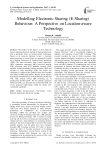
Modelling Electronic Sharing (E-Sharing) Behaviour: A Perspective on Location-aware Technology
Статья научная
The purpose of this paper is to investigate the factors affecting electronic sharing (E-sharing) behaviour, with a particular focus on location-aware technology. Based on an extensive literature review, a structural model consisting of seven factors was proposed to model the E-sharing behaviour of location-based knowledge (LBK). The main constructs were: reward expectancy (WE), reputation expectancy (RE), perceived benefits (PB), perceived trust (PT), attitudes towards LBK, attitudes toward knowledge sharing incentives (KSI) and intention to share knowledge (ISK). The model was examined by empirical data gathered from four hundred and ninety (n=490) respondents. Results herein indicate that attitude toward KSI can be determined by the RE and WE, while attitude toward LBK E-sharing can be predicted by the PB and PT. The two attitude constructs (KSI and LBK) can determine the behavioural ISK. All of the proposed relationships within the model were statistically significant.
Бесплатно
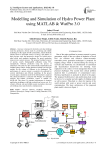
Modelling and Simulation of Hydro Power Plant using MATLAB & WatPro 3.0
Статья научная
Increase in demand of electricity and clean drinking water has produced a chronic need of a promising and reliable technology for the supply of both commodities, which should be entirely based on renewable sources of energy. The authors, in their previous work, had proposed a design of a hybrid power plant which used graphene membrane for power generation using reverse osmosis process. The proposal included removal of arsenic, poorly biodegradable pollutants using TiO2 nanoparticles. Chlorine production using the process of electrolysis. The plant was also electronically implemented and included pump control, fouling detection modules and decision module for the volume of effluents to be discharged. The performance of a power system is essential to be analyzed for control, stabilization and efficient modelling. In the present research paper, simulation model of the hybrid plant is analyzed. The chemical behavior is analyzed with 'Watpro 3.0' industrial software and turbine governance system is studied via MATLAB. This plant is a potential replacement of chemical purification techniques with high overhead and excess cost. It is a better, efficient, safe and reliable system to produce clean and safe drinking water and electricity simultaneously.
Бесплатно
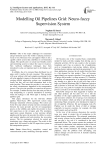
Modelling oil pipelines grid: neuro-fuzzy supervision system
Статья научная
One of the major challenges for researchers and governments across the world is reducing resources-waste or loss. Resources loss can happen if there is not a capable control system that contributes to environmental change. The specific aim is to create user-friendly control and monitoring system to reduce the waste in resources. New Artificial intelligence techniques have been introduced to play an important part in developing such systems. In oilfields, the oil is extracted then distributed via oil pipes until it reaches the end consumer. This operation will occur without a full and complete monitoring for the oil in the pipeline’s journey to the provider. Although, the existing oilfield monitoring systems can communicate locally but they will not send information back to the main provider. That means the provider is not aware of the whole circumstances happened in the transportation process. That gives the provider no control on the process. For example, a sudden decision from the main provider to stop transporting to a specific destination or knowing where the leakage is and which pipe is leaking in the pipelines grid. This paper, introduces for the first-time oilfield pipeline Neuro-fuzzy (NF) supervision system using Simscape simulation software package. This system can be the first step solution to keep real time communication between the main provider and the oil transportation process in the oilfields and enables the provider to have full supervision on the oil pipes grid. The simulation supervision system illustrates a clear real-time oilfield pipeline grid that gives the provider the ability to control and monitor pipeline grid and prioritise the recovering process. The two parameters selected for control and monitoring were volume and pressure. The results in this paper show full control for the NF supervision system on the transportation process.
Бесплатно
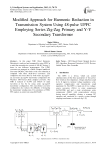
Статья научная
In this paper THD (Total Harmonic Distortion) is analysed and compared by using UPFC in a multi-line transmission system of 500 KV having 5-buses in two different arrangements. The UPFC converters are arranged as a Diode Clamped multilevel Converter (DCMLC) that leads to the cost reduction as compared with other multi-level converters. The comparison has been done by both series zig-zag/2Y-2Δ and series zig-zag/4Y transformer configuration for 48-pulses GTO based diode clamped converter. The THD is reduced to 42.59% and 58.82% of input waveform at bus B2 by using series zig-zag/4Y transformer configuration. This transformer converter configuration also reduces the difficulty of designing the transformer winding ratio. For calculation of THD, FFT analysis is carried out using MATLAB.
Бесплатно
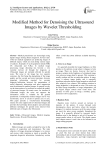
Modified Method for Denoising the Ultrasound Images by Wavelet Thresholding
Статья научная
Medical practitioners are increasingly using digital images during disease diagnosis. Several state-of-the-art medical equipment are producing images of different organs, which are used during various stages of analysis. Examples of such equipment include MRI, CT, ultrasound and X-Ray. In medical image processing, image denoising has become a very essential exercise all through the diagnosis as Ultrasound images are normally affected by speckle noise. The noise in the image has two negative outcomes, the first being the degradation of the image quality and the second and more important, obscures important information required for accurate diagnosis.Arbitration between the perpetuation of useful diagnostic information and noise suppression must be treasured in medical images. In general we rely on the intervention of a proficient to control the quality of processed images. In certain cases, for instance in Ultrasound images, the noise can suppress the information which is valuable for the general practitioner. Consequently medical images can be very inconsistent, and it is crucial to operate case to case. This paper presents a wavelet-based thresholding scheme for noise suppression in Ultrasound images and provides the knowledge about adaptive and anisotropic diffusion techniques for speckle noise removal from different types of images, like Ultrasound.
Бесплатно
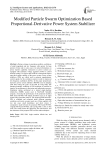
Modified Particle Swarm Optimization Based Proportional-Derivative Power System Stabilizer
Статья научная
During a change in operating condition, oscillations of small magnitude and low frequency often persist for long periods of time and in some cases even present limitations on power transfer capability. Generators in power systems are equipped with automatic voltage regulator (AVR) to control terminal voltage. It is known that AVR has a detrimental impact upon the dynamic stability of the power system. Power system stabilizers (PSS) are widely used to generate supplementary control signals for the excitation system in order to damp out low-frequency oscillations (LFOs). In this paper proportional-derivative power system stabilizer (PD-PSS) used to damping LFO after tuning the gains of the PSS by using PSO. The damping boundary condition of PSO technique is modified to improve its performance in the tuning and optimization process. Simulation studies performed on a typical single-machine infinite-bus (SMIB) system used in MATLAB Simulink program. Assessing the performance of the proposed modified PSO based PD-PSS with Speed deviation (∆ω) as an input signal using eigenvalue analysis. The proposed PSO based PD-PSS is evaluated and examined under different operating conditions and inertia constant each one of them applied with two test cases small disturbance and short circuit. A comparative study between the proposed PSO based PD-PSS, original PSO based PD-PSS, and lead-lag PSS is done in this work. The results ensure the superiority, the effectiveness, and the robustness of the proposed PSS over the other techniques.
Бесплатно
Momentum Based Level Set Method For Accurate Object Tracking
Статья научная
This paper proposes a novel object tracking method that is robust to a cluttered background and large motion. First, a posterior probability measure (PPM) is adopted to locate the object region. Then the momentum based level set is used to evolve the object contour in order to improve the tracking precision. To achieve rough object localization, the initial target position is predicted and evaluated by the Kalman filter and the PPM, respectively. In the contour evolution stage, the active contour is evolved on the basis of an object feature image. This method can acquire more accurate target template as well as target center. The comparison between our method and the kernelbased method demonstrates that our method can effectively cope with the deformation of object contour and the influence of the complex background when similar colors exist nearby. Experimental results show that our method has higher tracking precision.
Бесплатно

Monkey behavior based algorithms - a survey
Статья научная
Swarm intelligence algorithms (SIA) are bio-inspired techniques based on the intelligent behavior of various animals, birds, and insects. SIA are problem-independent and are efficient in solving real world complex optimization problems to arrive at the optimal solutions. Monkey behavior based algorithms are one among the SIAs first proposed in 2007. Since then, several variants such as Monkey search, Monkey algorithm, and Spider Monkey optimization algorithms have been proposed. These algorithms are based on the tree or mountain climbing and food searching behavior of monkeys either individually or in groups. They were designed with various representations, covering different behaviors of monkeys and hybridizing with the efficient operators and features of other SIAs and Genetic algorithm. They were explored for applications in several fields including bioinformatics, civil engineering, electrical engineering, networking, data mining etc. In this survey, we provide a comprehensive overview of monkey behavior based algorithms and their related literatures and discuss useful research directions to provide better insights for swarm intelligence researchers.
Бесплатно
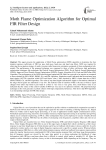
Moth Flame Optimization Algorithm for Optimal FIR Filter Design
Статья научная
This paper presents the application of Moth Flame optimization (MFO) algorithm to determine the best impulse response coefficients of FIR low pass, high pass, band pass and band stop filters. MFO was inspired by observing the navigation strategy of moths in nature called transverse orientation composed of three mathematical sub-models. The performance of the proposed technique was compared to those of other well-known high performing optimization techniques like techniques like Particle Swarm Optimization (PSO), Novel Particle Swarm Optimization (NPSO), Improved Novel Particle Swarm Optimization (INPSO), Genetic Algorithm (GA), Parks and McClellan (PM) Algorithm. The performances of the MFO based designed optimized FIR filters have proved to be superior as compared to those obtained by PSO, NPSO, INPSO, GA, and PM Algorithm. Simulation results indicated that the maximum stop band ripples 0.057326, transition width 0.079 and fitness value 1.3682 obtained by MFO is better than that of PSO, NPSO, INPSO, GA, and PM Algorithms. The value of stop band ripples indicated the ripples or fluctuations obtained at the range which signals are attenuated is very low. The reduced value of transition width is the rate at which a signal changes from either stop band to pass band of a filter or vice versa is very good. Also, small fitness value in an indication that the values of the control variable of MFO are very near to its optimum solutions. The proposed design technique in this work generates excellent solution with high computational efficiency. This shows that MFO algorithm is an outstanding technique for FIR filter design.
Бесплатно
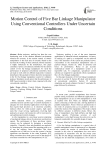
Статья научная
Robot trajectory tracking has been the core functioning unit in the modern industrial environment wherein the accuracy in the motion control of robotic manipulators is the main area of research. Based on the fact that the working of these automatic robotic machines is highly influenced by the disturbances, this paper constitutes various conventional controllers for the motion control of five bar linkage manipulator. To verify the performance of proposed conventional controllers, these are made to work with two different trajectories. Common disturbances like payload & friction has been incorporated in the five bar linkage manipulator system for validation purpose. Simulation results prove that the performance of SMC based controller is better when compared with other conventional controllers.
Бесплатно
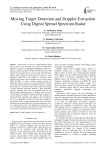
Moving Target Detection and Doppler Extraction Using Digital Spread Spectrum Radar
Статья научная
In this paper, we discuss a Spread Spectrum based radar system for car detection in the road and autonomous guidance of vehicles. An autonomous intelligent vehicle has to perform a number of functionalities. Segmentation of the road, determining the boundaries to drive in and recognizing the vehicles and obstacles around are the main tasks for vision guided vehicle navigation. In this article we propose a set of algorithms which lead to the solution of road and vehicle collision using carrier recovery method from car velocity using DSSS RADAR. In such a spread spectrum system, the transmitted signal is spread over a larger bandwidth, which is much wider than the minimum bandwidth required to transmit the information. Automotive radar systems can take advantage of spread spectrum techniques because of their interference rejection, immunity from noise and multipath distortion, and high resolution ranging properties. In addition, there is no need for high-speed, fast-settling frequency synthesizers. Moreover, spread spectrum techniques can improve the reliability of automotive radars. The data from different sensors on different cars can be combined in order to observe the complete car environment. Thus a spread spectrum radar system will allow sharing the same bandwidth also for data link needed by car-to-car communication systems. The algorithm described here is to recover Doppler frequency using 2P power method from which we are able to detect the vehicle condition in road.
Бесплатно
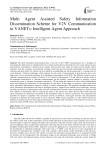
Статья научная
The safety information dissemination plays a vital role in the VANET communication. It is a technique of transmitting the information at scheduled intervals or during road hazards by detecting the events using onboard system and interfaces. Information is shared between vehicles and road side units which are further used to predict vehicle collisions, road line crossings, environmental warnings, traffic data and road hazards. Interestingly the risk of lateral collisions and dense traffic for vehicles can be avoided by accomplishing fast data dissemination i.e. warning alerts by event detection. Vehicular technology which supports the safe mode of transportation is growing faster due to the deployment of new automated technology in the intelligent transportation system (ITS). The different scenarios used in vehicular communication are Vehicle to Vehicle (V-V), Vehicle to Infrastructure (V-I) and Vehicle to Internet. Some of the important characteristics of vehicular communications are the mobility, frequent changes in topology, varying transmission power of antennas, intermittent connectivity. ITS providing the solutions for most critical transportation issues and inspiring the researchers for the betterment of road safety. In this paper, we propose a multi agent based safety information dissemination scheme for vehicle to vehicle communication. The proposed algorithm performs the safety information dissemination with help of intelligent agents by optimizing the channel access techniques, message encoding and selection of intermediate nodes. Here the communication between source and destination is achieved with fever number of intermediate links by selecting the nodes in the special zone. Short interval codes which represent safety information are effectively transmitted in the intermittent nature of wireless connectivity. This proposed work describes the details of algorithm with associated network environment, multi agent functions and dissemination mechanism to illustrate the improvement in end to end delay, PDR, energy constraints etc. This method reduces the problem of broadcast storm by delivering the information to intended node. Simulation of the proposed work gives the improved results on PDR, latency and connection overhead.
Бесплатно

